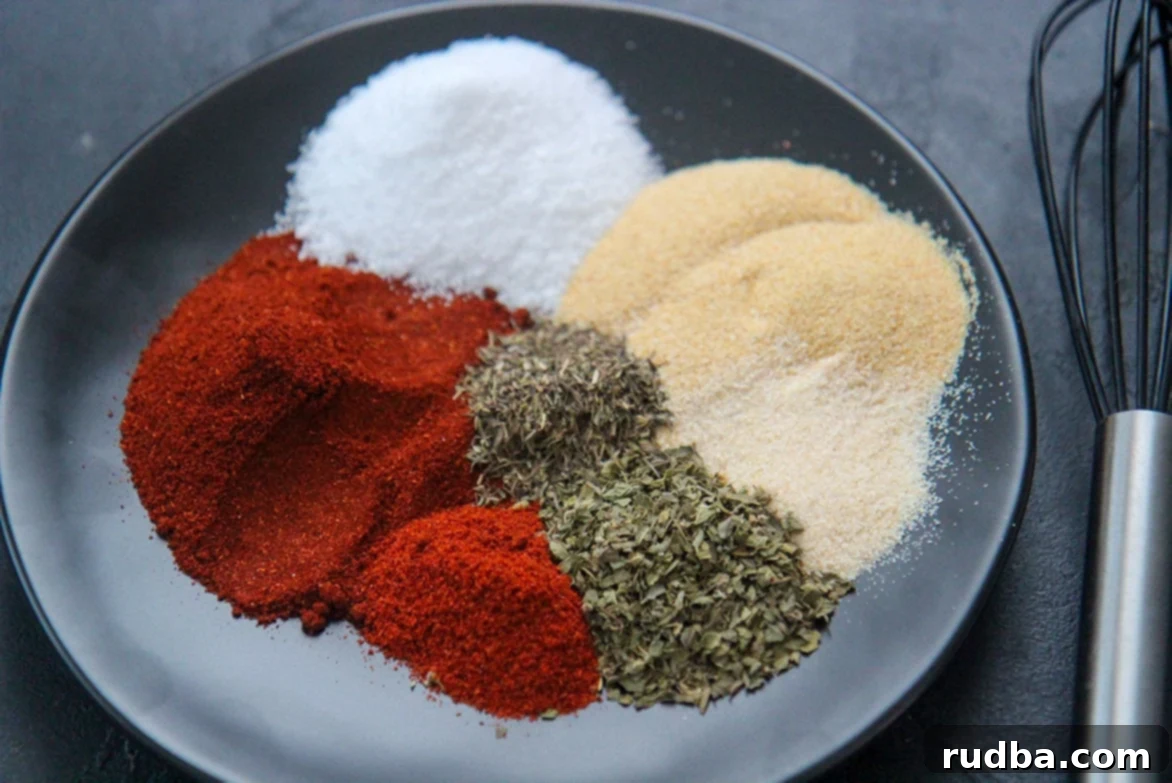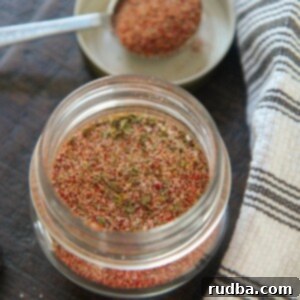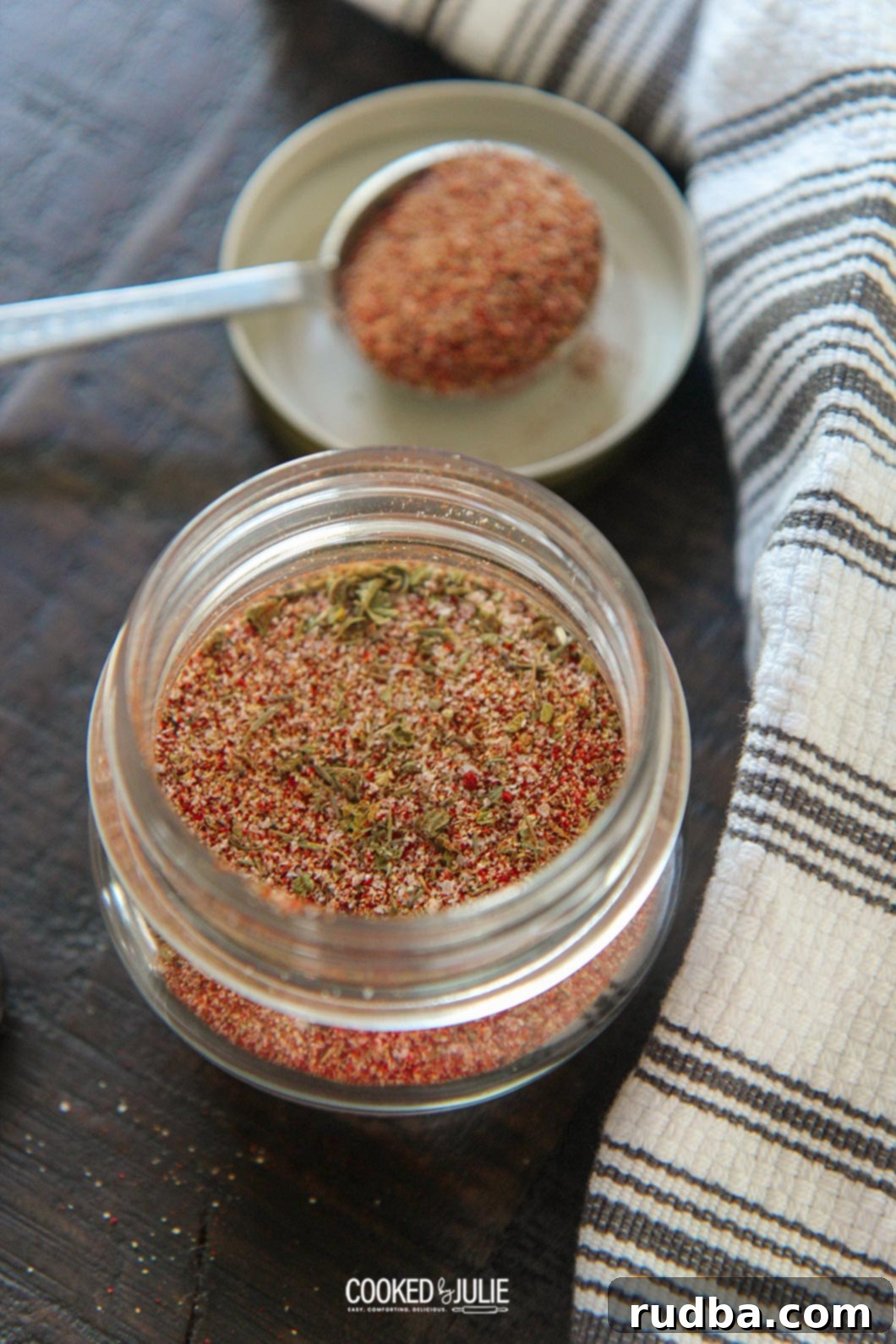Homemade Cajun Seasoning: The Best Easy Recipe & Why It’s Better Than Store-Bought
Are you ready to elevate your cooking with an explosion of flavor? This homemade Cajun seasoning recipe is incredibly easy to make and, trust us, it’s far superior to anything you’ll find on a store shelf. Forget overly salty or intensely spicy blends; our recipe delivers a perfectly balanced and utterly delicious Cajun seasoning that will become your new secret weapon in the kitchen. It’s ideal for almost every dish, adding that signature zest without overwhelming your palate.

Cajun seasoning stands out as one of the most vibrant and flavorful spice combinations in the culinary world. A harmonious mixture of staple ingredients like paprika, garlic powder, dried herbs, and a touch of cayenne pepper, this blend is a true treat for your senses. Its complex profile adds depth and a mild kick to countless dishes, transforming everyday meals into extraordinary culinary experiences. Some of our absolute favorite applications include a fiery Cajun Salmon and Shrimp and delightfully seasoned Cajun Beef Tacos!
A Journey to Louisiana: The Roots of Cajun Cuisine
To truly appreciate Cajun seasoning, it helps to understand its origins. Cajun cuisine is deeply rooted in the American South, particularly gaining immense popularity and defining characteristics in Louisiana. This region is home to the descendants of French settlers, known as Acadians, who were expelled from Canada in the 18th century and eventually settled in the bayous and prairies of Louisiana. Their resourcefulness and unique cultural heritage gave birth to “Cajun” culture and its distinctive culinary style.
Cajun food is renowned for its rustic, hearty flavors, often emphasizing local ingredients like seafood, rice, and fresh vegetables. The foundation of many Cajun dishes, known as the “holy trinity,” consists of bell peppers, onions, and celery (often complemented by garlic). By simply incorporating these fresh aromatics with a generous amount of Cajun seasoning, you can easily transform many ordinary recipes into “Cajun style” masterpieces. It’s all about richly flavored, well-seasoned food that celebrates bold tastes.
Classic examples of how this versatile blend can be used to add a unique twist to familiar dishes include Cajun Lasagna and Cajun Chicken Alfredo. My passion for creating new recipes with authentic Cajun flavors led me to realize the importance of sharing this easy homemade Cajun seasoning recipe. The best part? You likely already have most, if not all, of the necessary ingredients in your pantry, making this a truly accessible and rewarding DIY project!
Why Homemade Cajun Seasoning is the Best Choice
While store-bought Cajun seasoning is readily available, making your own offers several significant advantages:
- Control Over Ingredients: You dictate what goes into your blend. No hidden additives, anti-caking agents, or excessive sodium. This is crucial for dietary restrictions or simply a preference for natural ingredients.
- Freshness and Potency: Pre-made spice blends can sit on shelves for extended periods, losing their potency and vibrancy. Your homemade mix uses fresh spices, ensuring maximum flavor and aroma.
- Customizable Flavor Profile: As you’ll see, this recipe is a fantastic starting point, but you can easily adjust it to match your personal taste. Love more heat? Add extra cayenne! Prefer a milder blend? Reduce it.
- Cost-Effective: Buying individual spices in bulk is often more economical in the long run than repeatedly purchasing smaller, pre-mixed blends.
- No Unnecessary Fillers: Many commercial brands include fillers or excessive salt to cut costs. With homemade, you get pure, unadulterated spice.
The Essential Ingredients for Your Cajun Spice Blend
Crafting the perfect Cajun seasoning involves a thoughtful selection of common spices, each playing a vital role in creating that signature flavor profile. Here’s a breakdown of what you’ll need and why each ingredient is essential:
- Paprika: This vibrant red spice forms the base, providing a mild sweetness, beautiful color, and earthy undertones. You can use sweet paprika, or a smoked paprika for an added layer of smoky flavor.
- Kosher Salt: Essential for enhancing all the other flavors. We recommend Kosher salt for its pure taste and larger crystals, which are easy to measure. However, you can always adjust or omit it to make a salt-free blend.
- Granulated Garlic: A cornerstone of Cajun flavor. Granulated garlic offers a potent, savory garlic punch without the moisture of fresh garlic, which can clump your spice mix.
- Onion Powder: Works hand-in-hand with garlic powder to create an aromatic foundation. It provides a sweet and savory onion flavor that is indispensable for a well-rounded blend.
- Oregano: A classic herb in Mediterranean and Cajun cuisines, oregano brings earthy, slightly bitter, and peppery notes that contribute to the blend’s complexity.
- Thyme: With its subtle minty, lemony, and earthy flavor, thyme adds a delicate herbaceousness that complements the other strong spices beautifully.
- Cayenne Pepper: This is where the characteristic heat of Cajun seasoning comes from. Start with the recommended amount and adjust to your preferred level of spiciness.
- Black Pepper (Optional but Recommended): While not explicitly listed in the original, a good amount of freshly ground black pepper is a common addition to many Cajun blends, adding a sharp, piquant note.

Crafting Your Perfect Blend: A Step-by-Step Guide
Making your own Cajun seasoning couldn’t be simpler. It’s a quick process that yields incredible results, proving that the best flavors often come from the simplest preparations.
- Gather Your Ingredients: Measure out all the specified spices (paprika, kosher salt, granulated garlic, onion powder, oregano, thyme, and cayenne pepper) into a medium-sized mixing bowl. Ensure your measuring spoons are clean and dry to prevent clumping.
- Whisk to Combine: Using a whisk or a small spoon, thoroughly combine all the spices. Mix well until there are no visible clumps and the color is uniform throughout. This ensures that every pinch of your seasoning delivers a consistent flavor profile.
- Transfer and Store: Carefully pour the freshly mixed seasoning into an airtight spice jar. A funnel can be very helpful here to avoid spills. Label the jar with the date it was made and the name of the spice blend.
Your freshly made homemade Cajun seasoning will maintain its peak freshness and potency for up to 6 months when stored correctly. While it won’t “go bad” after this period, its flavors will gradually diminish.
Customize Your Cajun Seasoning to Your Liking
One of the greatest advantages of making your own spice blends is the ability to adjust them to your personal preferences. This Cajun seasoning recipe is a perfect canvas for customization:
- Spice Level: Love the heat? Feel free to add more cayenne pepper, a quarter teaspoon at a time, until it reaches your desired kick. For a milder version, simply reduce the amount of cayenne.
- A Touch of Sweetness: For a slightly different flavor profile, consider adding a tablespoon of brown sugar. This can balance the heat and savory notes, creating a beautiful contrast, especially for grilled meats.
- Smoky Undertones: Swap regular paprika for smoked paprika to infuse your blend with a rich, smoky depth. This works wonderfully with grilled or roasted dishes.
- Herbal Twist: Experiment with other dried herbs like basil or marjoram for a slightly different aromatic complexity.
- Salt-Free Option: If you are monitoring your sodium intake, feel free to completely omit the kosher salt from the recipe. This allows you to season your food with salt separately, giving you precise control.
Storing Your Homemade Spice Blend for Maximum Freshness
Proper storage is paramount to ensure your homemade Cajun seasoning remains potent and flavorful for as long as possible. Spices, when exposed to air, light, heat, and moisture, can quickly lose their aroma and taste.
- Airtight Containers are Key: Always store your spice blends in airtight containers. This prevents air and moisture from degrading the spices.
- Glass Jars are Ideal: Consider using small glass spice jars with tightly sealed lids. Glass is non-porous, meaning it won’t absorb flavors or odors, and it won’t allow air or moisture to penetrate.
- Cool, Dark, and Dry: The ideal environment for spice storage is a cool, dark cupboard or pantry. Keep them away from direct sunlight, the heat generated by your stove or oven, and any sources of moisture. Humidity can cause spices to clump and lose their flavor.
- Label Everything: Don’t forget to label your spice jars with the name of the blend and the date it was made. This simple practice helps you keep track of freshness and ensures you’re always using the best quality spices in your cooking. Remember, fresh spices can truly make or break a recipe!
Unleashing the Flavor: How to Use Cajun Seasoning
If you’re a true fan of bold flavors and vibrant cuisine, a small jar of homemade Cajun seasoning is an absolute pantry essential. Its incredible versatility means it can transform a wide array of dishes. Here’s a comprehensive list of delicious ways you can incorporate this fantastic spice blend into your cooking:
- Meats & Poultry:
- Roasted, Baked, or Grilled Chicken: Rub it generously on chicken breasts, thighs, or a whole chicken before cooking for a juicy, flavorful crust.
- Steak: A fantastic dry rub for any cut of steak, imparting a spicy, savory kick.
- Pork: Great on pork chops, tenderloin, or even pulled pork.
- Ground Meats: Mix into ground beef, turkey, or sausage for burgers, meatloaf, or taco fillings.
- Seafood:
- Salmon & White Fish: Sprinkle on fillets before baking, pan-searing, or grilling for an instant flavor boost.
- Shrimp: Perfect for sautéed, grilled, or roasted shrimp. It pairs wonderfully with garlic butter.
- Scallops: Add a zesty touch to pan-seared scallops.
- Crab Boils: Essential for a classic Louisiana-style seafood boil.
- Vegetables:
- Roasted, Steamed, or Grilled Veggies: Toss with olive oil and then sprinkle generously on broccoli, cauliflower, asparagus, bell peppers, zucchini, or potatoes before roasting or grilling.
- Corn on the Cob: A delicious alternative to just salt and butter.
- Sweet Potatoes: Adds a savory-spicy contrast to sweet potato fries or roasted wedges.
- Soups, Stews & Gumbos:
- Chili: Enhance the warmth and depth of your favorite chili recipe.
- Gumbo & Jambalaya: Absolutely crucial for authentic Louisiana stews and rice dishes.
- Soups: Add a pinch to creamy tomato soup, lentil soup, or chicken noodle soup for an unexpected twist.
- Pasta & Grains:
- Pasta Dishes: Stir into creamy sauces, like Alfredo, or tomato-based pasta dishes for a spicy kick.
- Rice: Mix into plain rice, dirty rice, or red beans and rice.
- Breakfast & Brunch:
- Eggs: Sprinkle on scrambled eggs, omelets, or frittatas.
- Hash Browns: Season your crispy potatoes for extra flavor.
- Snacks & Appetizers:
- Popcorn: A gourmet topping for your movie night popcorn.
- Fries & Tater Tots: Sprinkle over hot fries for a seasoned treat.
- Dips: Mix into sour cream or mayonnaise-based dips.
Frequently Asked Questions (FAQs) About Cajun Seasoning
Does this Cajun seasoning recipe include salt?
Yes, our recipe includes kosher salt to enhance the overall flavor profile. However, if you are watching your sodium intake or prefer to control the saltiness separately, you are absolutely welcome to completely omit the salt and make this a salt-free Cajun seasoning blend. You can then add salt to your dish according to your taste.
How long does homemade Cajun seasoning last?
When stored in an airtight container in a cool, dark place, your homemade Cajun seasoning will stay fresh and potent for up to 6 months. Beyond that, it won’t spoil, but its flavors will gradually diminish.
Is Cajun seasoning always spicy?
Cajun seasoning is known for its mild to moderate heat, primarily from cayenne pepper. However, the beauty of making it yourself is that you can customize the spice level. You can increase or decrease the amount of cayenne pepper to suit your personal preference, from a subtle warmth to a fiery kick.
What’s the difference between Cajun and Creole seasoning?
While often confused, Cajun and Creole cuisines have distinct differences. Cajun cuisine is typically more rustic, rural, and relies heavily on one-pot cooking with a focus on local ingredients and simple preparations. Cajun seasoning often emphasizes paprika, cayenne, garlic, onion, and herbs like oregano and thyme, with less reliance on fresh herbs or a broader array of spices.
Creole cuisine, on the other hand, is considered more urban, “city food” with French, Spanish, African, and Caribbean influences. Creole seasoning tends to be more complex, often including more herbs (like bay leaf, basil) and spices (like white pepper, celery seed), and sometimes even a touch of allspice or nutmeg. While both share some common ingredients, Creole blends often have a more nuanced, sometimes less fiery, flavor profile.

Don’t wait any longer to elevate your culinary creations! Try adding this easy homemade Cajun seasoning to these fantastic recipes for an extra kick of authentic flavor:
- Roasted Parmesan Brussel Sprouts
- Spaghetti Squash with Garlic Chicken
- Grilled Shrimp Po’Boy
- Creamy Garlic Shrimp
- Pan Seared Salmon with Lemon Butter

Cajun Seasoning
Save RecipeSaved Recipe
Pin Recipe
Rate Recipe
Print Recipe
Ingredients
- 3 tbsp Paprika
- 2 tbsp Kosher Salt
- 2 tbsp Granulated Garlic
- 1 tbsp Onion Powder
- 1/2 tbsp Thyme
- 1 tbsp Oregano
- 1/2 tbsp Cayenne Pepper
Instructions
-
Combine all of the ingredients in a bowl and then transfer to an airtight container.
Nutrition
Nutrition information is automatically calculated, so should only be used as an approximation.
Additional Info
Like this recipe? Leave a comment below!
